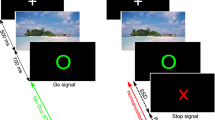Abstract
Tourette Syndrome (TS) is a developmental neurological condition that is characterised by the presence of multiple motor and one or more vocal tics. Tics are highly stereotyped repetitive behaviours that fluctuate in type, complexity and severity. TS has been linked to impaired cognitive control processes, however, a recent study (Mueller et al. in Curr Biol 16:570–573, 2006) demonstrated that young people with TS, although exhibiting chronic motor and vocal tics, nevertheless performed significantly better than a group of age-matched controls on a task that required extremely high levels of cognitive control (i.e., predictably shifting between executing pro-saccade and anti-saccade responses to a visual stimulus). As predictable task sequences allow task-related cognitive processes to commence prior to the presentation of target stimuli we examined whether the superior performance of the TS group could be replicated when task sequences were varied unpredictably. Our results confirmed that both the TS group and an age-matched control group benefited, by the same extent, when the saccade task (pro-saccade vs. anti-saccade) was pre-cued. In contrast, while the control group showed a significant decrease in performance on task switch trials relative to task repetition trials—the TS group exhibited no significant ‘costs’ of switching task. While task performance was modulated by response and target location shifts in the control group, these factors had less impact on the TS group’s performance on task switch trials. These results confirm and extend the previous demonstration that individuals with TS exhibit paradoxically greater levels of cognitive control than healthy controls.





Similar content being viewed by others
References
Albin RL, Mink JW (2006) Recent advances in Tourette Syndrome research. Trends Neurosci 29:175–182
Alexander GE, DeLong MR, Strick PL (1986) Parallel organization of functionally segregated circuits linking basal ganglia and cortex. Annu Rev Neurosci 9:357–381
Banaschewski T, Woerner W, Rothenberger A (2003) Premonitory sensory phenomena and suppressibility of tics in Tourette syndrome: developmental aspects in children and adolescents. Dev Med Child Neurol 45(10):700–703
Barton JJS, Greenzang C, Hefter R, Edelman J, Manoach DS (2006) Switching, plasticity, and prediction in a saccadic task-switch paradigm. Exp Brain Res 168:76–87
Bialystok E, Senman L (2004) Executive processes in appearance-reality tasks: the role of inhibition of attention and symbolic representation. Child Dev 75:562–579
Fecteau JH, Armstrong IT, Munoz DP (2004) Sensory biases produce alternation advantage found in sequential saccadic eye movement tasks. Exp Brain Res 159:84–91
Georgiou N, Bradshaw JL, Phillips JG, Bradshaw JA, Chiu E (1995) The Simon effect and attention deficits in Gilles de la Tourette’s Syndrome and Huntington’s disease. Brain 118:1305–1318
Goodman R (2001) Psychometric properties of the strengths and difficulties questionnaire. J Am Acad Child Adolesc Psychiatry 40:1337–1345
Hays JR, Reas DL, Shaw JB (2002) Concurrent validity of the Wechsler abbreviated scale of intelligence and the Kaufman brief intelligence test among psychiatric inpatients. Psychol Rep 90:355–359
Jackson GM (2006) Tourette’s Syndrome. Curr Biol 16:443–444
Koch I (2005) Sequential task predictability in task switching. Psychon Bull Rev 12:107–112
Leckman JF, Riddle MA, Hardin MT, Ort SI, Swartz KL, Stevenson J, Cohen DJ (1989) The Yale Global Tic Severity Scale: initial testing of a clinician-rated scale of tic severity. J Am Acad Child Adolesc Psychiatry 28:566–573
Leckman JF, Zhang H, Vitale A, Lahnin F, Lynch K, Bondi C, Kim Y-S, Peterson BS (1998) Course of tic severity in Tourette Syndrome: the first two decades. Pediatrics 102:14–19
Leckman JF, Vaccarino FM, Kalanithi PS, Rothenberger A (2006) Annotation: Tourette Syndrome: a relentless drumbeat—driven by misguided brain oscillations. J Child Psychol Psychiatry 47:537–550
Mink JW (1996) The basal ganglia: focused selection and inhibition of competing motor programs. Progr Neurobiol 50:381–425
Monsell S (2003) Task switching. Trends Cogn Sci 7:134–140
Mostofsky SH, Lasker AG, Singer HS, Denckla MB, Zee DS (2001) Oculomotor abnormalities in boys with Tourette Syndrome with and without ADHD. J Am Acad Child Adolesc Psychiatry 40:1464–1472
Mueller SC (2006) Contributions of task and response-level factors to the asymmetrical switch cost. Unpublished doctoral dissertation. School of Psychology, University of Nottingham, Nottingham
Mueller SC, Jackson GM, Dhalla R, Datsopoulos S, Hollis CP (2006) Enhanced cognitive control in young people with Tourette’s Syndrome. Curr Biol 16:570–573
Muris P, Meesters C, van den Berg F (2003) The strength and difficulties questionnaire (SDQ)—further evidence for its reliability and validity in a community sample of Dutch children and adolescents. Eur Child Adolesc Psychiatry 12:1–8
Peterson BS, Skudlarski P, Anderson AW, Zhang H, Gatenby JC, Lacadie CM, Leckman JF, Gore JC (1998) A functional magnetic resonance imaging study of tic suppression in Tourette Syndrome. Arch Gen Psychiatry 55:326–333
Rafal R, Egly R, Rhodes D (1994) Effects of inhibition of return on voluntary and visually guided saccades. Can J Exp Psychol 48:284–300
Redgrave P, Prescott TJ, Gurney K (1999) The basal ganglia: a vertebrate solution to the selection problem? Neuroscience 89:1009–1023
Reulen JPH, Marcus JT, Koops D, de Vries FR, Tiesinga G, Boshuizen K, Bos JE (1988) Precise recording of eye movement: the IRIS technique Part 1. Med Biol Eng Comput 26:20–26
Reuter B, Philipp AM, Koch I, Kathmann N (2006) Effects of switching between leftward and rightward pro- and antisaccades. Biol Psychol 72:88–95
Serrien DJ, Orth M, Evans AH, Lees AJ, Brown P (2005) Motor inhibition in patients with Gilles de la Tourette Syndrome: functional activation patterns as revealed by EEG coherence. Brain 128:116–125
Swainson R, Jackson SR, Jackson GM (2006) Using advance information in dynamic cognitive control: an ERP study of task-switching. Brain Res 1105:61–72
Walkup TJ, Rosenberg LA, Brown J, Singer HS (1992) The validity of instruments measuring tic severity in Tourette’s Syndrome. J Am Acad Child Adolesc Psychiatry 31:472–477
Author information
Authors and Affiliations
Corresponding author
Rights and permissions
About this article
Cite this article
Jackson, G.M., Mueller, S.C., Hambleton, K. et al. Enhanced cognitive control in Tourette Syndrome during task uncertainty. Exp Brain Res 182, 357–364 (2007). https://doi.org/10.1007/s00221-007-0999-8
Received:
Accepted:
Published:
Issue Date:
DOI: https://doi.org/10.1007/s00221-007-0999-8




